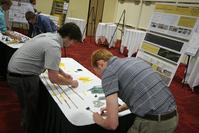Bridge competition inspires undergraduate investigation in seismic design
On May 20, 2013, engineering students from five universities vied for the sturdiest bridge design at the Seventh National Seismic Conference on Bridges & Highways (7NSC) in Oakland, California. The K’NEX Bridge Competition required the undergraduate teams to create designs for a bridge slated for inclusion in a new San Francisco Bay Area highway system.
Naturally, bridges in the Bay Area must be seismically sound.
At the professional conference in Oakland, the teams tested their 1.5 meter long K’NEX bridges by subjecting them to seismic motions simulating the Kobe, Loma Prieta and Landers earthquakes.
After points were tallied, the winners were the Oregon State University Beavers, closely followed by the University of Michigan Huskies.
The competition attracted 10 teams from all over the United States; a team from Croatia even joined the mix. The five semi-finalists were from Oregon State University, Michigan Technological University, Purdue University, the University of California San Diego, and the University of Michigan. The Purdue team was comprised of Barnard Mondal (team captain), Richard “Richie” Gallina, Jr, and Kyle Johnson.
The real-time competition was intense. As conference attendees watched and cheered them on, the semi-finalist teams assembled their K’NEX bridges and tested them on the instructional shake table set up on the conference floor.
All of the structures performed very well in the simulated earthquakes, showing that the students had applied good seismic design principles.
Teams were scored on a variety of design and performance parameters including efficient use of construction materials, construction time, and the structure’s stiffness and ability to hold vehicles without bowing or bending. Much structural design involves accurate computer modeling, so teams were also graded on their ability to predict the seismic behavior of their bridges using analytical tools.
Teams documented their designs in posters, which are still available at the NEEShub. Students, faculty and practitioners in the earthquake engineering community voted for their favorite designs.
The competition was organized by NEES, the Pacific Earthquake Engineering Research Center (PEER), MCEER, University at Buffalo, Caltrans, AASHTO, the Federal Highway Administration and the Transportation Research Board.
(Article referenced from NEES.org)

